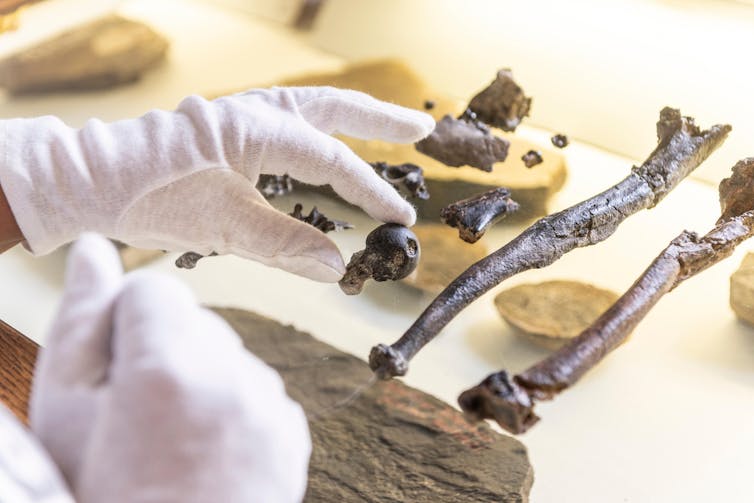Why Some Scientists Want to Rewrite the History of How we Learned to Walk
Looking at a fossilised animal’s anatomy does give us insights into the forces that would have operated on its bones and so how it commonly moved.
It’s not often that a fossil truly rewrites human evolution, but the recent discovery of an ancient extinct ape has some scientists very excited. According to its discoverers, Danuvius guggenmosi combines some human-like features with others that look like those of living chimpanzees. They suggest that it would have had an entirely distinct way of moving that combined upright walking with swinging from branches. And they claim that this probably makes it similar to the last shared ancestor of humans and chimps.
We are not so sure. Looking at a fossilised animal’s anatomy does give us insights into the forces that would have operated on its bones and so how it commonly moved. But it’s a big leap to then make conclusions about its behaviour, or to go from the bones of an individual to the movement of a whole species. The Danuvius fossils are unusually complete, which does provide some vital new evidence. But how much does it really tell us about how our ancestors moved around?
Danuvius has long and mobile arms, habitually extended (stretched out) legs, feet which could sit flat on the floor, and big toes with a strong gripping action. This is a unique configuration. Showing that a specimen is unique is a prerequisite for classifying it as belonging to a separate, new species that deserves its own name.
But what matters in understanding the specimen is how we interpret its uniqueness. Danuvius’s discoverers go from describing its unique anatomy to proposing a unique pattern of movement. When we look at living apes, the relationship between anatomy and movement is not so simple.
The Danuvius find actually includes fossils from four individuals, one of which is nearly complete. But even a group of specimens may not be typical of a species more generally. For instance, humans are known for walking upright not climbing trees, but the Twa hunter-gatherers are regular tree climbers. These people, whose bones look just like ours, have distinctive muscles and ranges of movement well beyond the human norm. But you could not predict their behaviour from their bones.

Every living ape uses a repertoire of movements, not just one. For example, orang-utans use clambering, upright or horizontal climbing, suspensory swinging and assisted bipedalism (walking upright using hands for support). Their movement patterns can vary in complex ways because of individual preference, body mass, age, sex or activity.
Gorillas, meanwhile, are “knuckle-walkers” and we used to think they were unable to stand fully upright. But the “walking gorilla” Ambam is famous for his “humanlike” stride.
Ultimately, two animals with very similar anatomies can move differently, and two with different anatomies can move in the same way. This means that Danuvius may not be able to serve as a model for our ancestors’ behaviour, even if its anatomy is similar to theirs.
In fact, we believe there are other plausible interpretations of Danuvius’s bones. These alternatives give a picture of a repertoire of potential movements that may have been used in different contexts.
For example, one of Danuvius‘s most striking features is the high ridge on the top of its shinbone, which the researchers say is associated with “strongly developed cruciate ligaments”, which stabilise the knee joint. The researchers link these strong stabilising ligaments with evidence for an extended hip and a foot that could be placed flat on the floor to suggest that this ape habitually stood upright. Standing upright could be a precursor to bipedal walking, so the authors suggest that this means Danuvius could have been like our last shared ancestor with other apes.
However, the cruciate ligaments also work to stabilise the knee when the leg is rotating. This only happens when the knee is bent with the foot on the ground. This is why skiers who use knee rotation to turn their bodies often injure these ligaments.
Other explanations
We have not seen the Danuvius bones in real life. But, based on the reserachers’ excellent images and descriptions, an equally plausible interpretation of the pronounced ridge on the top of the shinbone could be that the animal used its knee when it was bent, with significant rotational movement.
Perhaps it hung from a branch above and used its feet to steer by gripping branches below, rather than bearing weight through the feet. This could have allowed it to capitalise on its small body weight to access fruit on fine branches. Alternatively, it could have hung from its feet, using the legs to manoeuvre and the hands to grasp.
All of these movements fit equally well with Danuvius’ bones, and could be part of its movement repertoire. So there is no way to say which movement is dominant or typical. As such, any links to our own bipedalism look much less clear-cut.
Danuvius is undoubtedly a very important fossil, with lots to teach us about how varied ape locomotion can be. But we would argue that it is not necessarily particularly like us. Instead, just like living apes, Danuvius would probably have displayed a repertoire of different movements. And we can’t say which would have been typical, because anatomy is not enough to reconstruct behaviour in full.
![]()
Vivien Shaw, Lecturer in Anatomy, Bangor University and Isabelle Catherine Winder, Lecturer in Zoology, Bangor University
This article is republished from The Conversation under a Creative Commons license. Read the original article.
Image: Reuters
